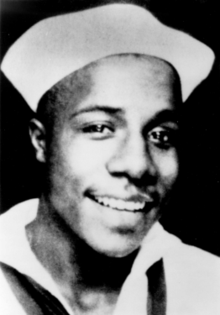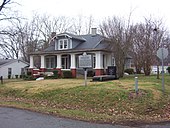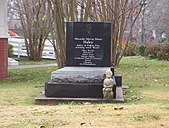BLACK SOCIAL HISTORY Alex Haley
| Alex Haley | |
|---|---|

Haley during his tenure in the U.S. Coast Guard
| |
| Born | Alexander Murray Palmer Haley August 11, 1921 Ithaca, New York, U.S.[1] |
| Died | February 10, 1992 (aged 70) Seattle, Washington, U.S. |
| Occupation | Writer |
| Alma mater | Alcorn State University Elizabeth City State College |
| Spouse | Nannie Branch (1941-1964) Juliette Collins (1964-1972) Myra Lewis (1977-1992)[2] (his death) |
| Military career | |
| Allegiance | |
| Service/branch | |
| Years of service | 1939–1959 |
| Rank | |
| Battles/wars | World War II |
Alexander Murray Palmer "Alex" Haley (August 11, 1921 – February 10, 1992)[1] was an American writer known as the author of the 1976 book Roots: The Saga of an American Family. The book was adapted by ABC as a TV mini-series of the same name and aired in 1977 to a record-breaking 130 million viewers. It had great influence on awareness in the United States of African-American history and inspired a broad interest in genealogy and family history.
Haley's first book was 1965's The Autobiography of Malcolm X, a collaboration through numerous lengthy interviews with the subject, a major African-American leader.[3][4][5]
He was working on a second family history novel at his death. Haley had requested that David Stevens, a screenwriter, complete it; the book was published as Alex Haley's Queen. It was adapted as a film of the same name released in 1993.
Early life and education
Alex Haley was born in Ithaca, New York, on August 11, 1921, and was the oldest of three brothers and a sister. Haley lived with his family in Henning, Tennessee, before returning to Ithaca with his family when he was five years old. Haley's father was Simon Haley, a professor of agriculture at Alabama A&M University, and his mother was Bertha George Haley (née Palmer) who was from Henning. The family had African American, Cherokee, Scottish, and Scots-Irishroots.[6][7][8][9] The younger Haley always spoke proudly of his father and the obstacles of racismhe had overcome.
Like his father, Alex Haley was enrolled at age 15 in Alcorn State University, a historically black college, and, a year later, enrolled at Elizabeth City State College, also historically black, in North Carolina. The following year he returned to his father and stepmother to tell them he had withdrawn from college. His father felt that Alex needed discipline and growth, and convinced him to enlist in the military when he turned 18. On May 24, 1939, Alex Haley began what became a 20-year career with the United States Coast Guard.[10]
Coast Guard career
Haley enlisted as a mess attendant. Later he was promoted to the rate of petty officer third-class in the rating of steward, one of the few ratings open to African Americans at that time. It was during his service in the Pacific theater of operations that Haley taught himself the craft of writing stories. During his enlistment he was often paid by other sailors to write love letters to their girlfriends. He said that the greatest enemy he and his crew faced during their long voyages was not the Japanese forces but rather boredom.[10]
After World War II, Haley petitioned the U.S. Coast Guard to allow him to transfer into the field of journalism. By 1949 he had become a petty officer first class in the rating of journalist. He later advanced to chief petty officer and held this grade until his retirement from the Coast Guard in 1959. He was the first Chief Journalist in the Coast Guard, the rating having been expressly created for him in recognition of his literary ability.[10]
Haley's awards and decorations from the Coast Guard include the Coast Guard Good Conduct Medal (with 1 silver and 1 bronze service star), American Defense Service Medal(with "Sea" clasp), American Campaign Medal, Asiatic-Pacific Campaign Medal, European-African-Middle Eastern Campaign Medal, World War II Victory Medal, Korean Service Medal, National Defense Service Medal, United Nations Service Medal, and the Coast Guard Expert Marksmanship Medal.[10] Additionally, he was awarded the War Service Medal by the Republic of Korea ten years after his death.
Literary career[edit]
After retiring from the U.S. Coast Guard, Haley began another phase of his journalism career. He eventually became a senior editor for Reader's Digest magazine.
Playboy magazine[edit]
Haley conducted the first interview for Playboy magazine. His interview with jazz musician Miles Davis appeared in the September 1962 issue. Haley elicited candid comments from Davis about his thoughts and feelings on racism. That interview set the tone for what became a significant feature of the magazine. Rev. Martin Luther King, Jr.'s PlayboyInterview with Haley was the longest he ever granted to any publication.[11]
Throughout the 1960s, Haley was responsible for some of the magazine's most notable interviews, including one with George Lincoln Rockwell, leader of the American Nazi Party. He agreed to meet with Haley only after gaining assurance from the writer that he was not Jewish. Haley remained professional during the interview, although Rockwell kept a handgun on the table throughout it. (The interview was recreated in Roots: The Next Generations, with James Earl Jones as Haley and Marlon Brando as Rockwell.) Haley also interviewed Muhammad Ali, who spoke about changing his name from Cassius Clay. Other interviews include Jack Ruby's defense attorney Melvin Belli, entertainer Sammy Davis, Jr., football player Jim Brown, TV host Johnny Carson, and music producer Quincy Jones.
The Autobiography of Malcolm X[edit]
The Autobiography of Malcolm X, published in 1965, was Haley's first book.[12] It describes the trajectory of Malcolm X's life from street criminal to national spokesman for theNation of Islam to his conversion to Sunni Islam. It also outlines Malcolm X's philosophy of black pride, black nationalism, and pan-Africanism. Haley wrote an epilogue to the book summarizing the end of Malcolm X's life, including his assassination in New York's Audubon Ballroom.
Haley ghostwrote The Autobiography of Malcolm X based on more than 50 in-depth interviews he conducted with Malcolm X between 1963 and Malcolm X's February 1965 assassination.[13] The two men had first met in 1960 when Haley wrote an article about the Nation of Islam for Reader's Digest. They met again when Haley interviewed Malcolm X for Playboy.[13]
The first interviews for the autobiography frustrated Haley. Rather than discussing his own life, Malcolm X spoke about Elijah Muhammad, the leader of the Nation of Islam; he became angry about Haley's reminders that the book was supposed to be about Malcolm X. After several meetings, Haley asked Malcolm X to tell him something about his mother. That question drew Malcolm X into recounting his life story.[13][14]
The Autobiography of Malcolm X has been a consistent best-seller since its 1965 publication.[15] The New York Times reported that six million copies of the book had sold by 1977.[4] In 1998, TIME magazine ranked The Autobiography of Malcolm X as one of the 10 most influential nonfiction books of the 20th century.[16]
In 1966, Haley received the Anisfield-Wolf Book Award for The Autobiography of Malcolm X.
Super Fly T.N.T.[edit]
In 1973, Haley wrote his only screenplay, Super Fly T.N.T.. The film starred and was directed by Ron O'Neal.
Roots[edit]
In 1976, Haley published Roots: The Saga of an American Family, a novel based on his family's history, going back to slavery days. It started with the story of Kunta Kinte, who was kidnapped in the Gambia in 1767 and transported to the Province of Maryland to be sold as a slave. Haley claimed to be a seventh-generation descendant of Kunta Kinte, and his work on the novel involved ten years of research, intercontinental travel and writing. He went to the village of Juffure, where Kunta Kinte grew up and which had continued, and listened to a tribal historian (griot) tell the story of Kinte's capture.[1] Haley also traced the records of the ship, The Lord Ligonier, which he said carried his ancestor to the Americas.
Haley has stated that the most emotional moment of his life occurred on September 29, 1967, when he stood at the site in Annapolis, Maryland, where his ancestor had arrived from Africa in chains exactly 200 years before. A memorial depicting Haley reading a story to young children gathered at his feet has since been erected in the center of Annapolis.
Roots was eventually published in 37 languages. Haley won a special Pulitzer Prize for the work in 1977.[17] The same year, Roots was adapted as a popular television miniseriesof the same name by ABC. The serial reached a record-breaking 130 million viewers. Roots emphasized that African Americans have a long history and that not all of that history is necessarily lost, as many believed. Its popularity also sparked a greatly increased public interest in genealogy.
In 1979, ABC aired the sequel miniseries, Roots: The Next Generations, which continued the story of Kunta Kinte's descendants. It concluded with Haley's travel to Juffure. Haley was portrayed at different ages by Kristoff St. John, The Jeffersons actor Damon Evans, and Tony Award winner James Earl Jones.
Haley was briefly a "writer in residence" at Hamilton College in Clinton, New York, where he began work on Roots. He enjoyed spending time at a local bistro called "The Savoy" in nearby Rome, where he would sometimes pass the time listening to the piano player. Today, there is a special table in honor of Haley, with a painting of Haley writing Roots on a yellow legal tablet.
Plagiarism dispute and other criticism[edit]
Genealogists have since disputed Haley's research and conclusions. Additionally, in 1978, Harold Courlander, filed suit in the U.S. District Court for the Southern District of New York, charging that Alex Haley had copied 81 passages from his novel, The African.[18] Courlander's pre-trial memorandum in the copyright infringement lawsuit stated:
In his expert witness report submitted to the federal court in support of Courlander's claim, Michael Wood, professor of English at Columbia University, stated:
After a five-week trial in the federal district court, Courlander and Haley settled the case with a financial settlement and a statement that "Alex Haley acknowledges and regrets that various materials from The African by Harold Courlander found their way into his book Roots."[21] During the trial, presiding U.S. District Court Judge Robert J. Ward stated: "Copying there is, period."[22] In a later interview with BBC Television, Judge Ward said that Haley had "perpetrated a hoax on the public".[23]
Throughout the trial, Haley maintained that he had not read The African before writing Roots. Shortly after the trial, however, a minority studies teacher at Skidmore College, Joseph Bruchac III, came forward and swore in an affidavit that he had discussed The African with Haley in 1970 or 1971 and had given his own personal copy of the novel to Haley. This event took place several years before Roots was published.[24]
In addition to the charges of plagiarism, the accuracy of those aspects of Roots which Haley claimed to be true has also been challenged.[25] Although Haley acknowledged that the novel was primarily a work of fiction, he claimed to have identified his ancestor in the person of Kunta Kinte, an African taken from the village of Jufureh in what is now the Gambia. According to Haley, Kunta Kinte was sold into slavery, where he was given the name Toby. While in the service of a slavemaster named John Waller, Kinte fathered a daughter named Kizzy, Haley's 3xgreat-grandmother. Haley also claimed to have identified the specific slave ship and the specific voyage on which Kunta Kinte was transported from Africa to North America in 1767.
Genealogist Elizabeth Shown Mills and historian Gary B. Mills, both specialists in African-American research, revisited Haley's research and concluded Haley's claims were false.[26][27] According to the Millses, the slave named Toby owned by John Waller could be definitively documented as having been in North America as early as 1762. They also reported, among other findings, that Toby died years prior to the supposed birth date of his daughter Kizzy.
Other commentators have suggested that Kebba Kanji Fofana, the amateur griot in Jufureh, who, during Haley's visit, confirmed the tale of Kunta Kinte's being taken captive, had been coached to relate such a story.[28][29][30]
Haley and his work have been excluded from the Norton Anthology of African-American Literature, despite his status as the United States' best-selling African-American author. Harvard University professor Dr. Henry Louis Gates, Jr., one of the anthology's general editors, has denied that the controversies surrounding Haley's works are the reason for this exclusion. In 1998 Dr. Gates acknowledged the doubts surrounding Haley's claims about Roots, saying, "Most of us feel it's highly unlikely that Alex actually found the village whence his ancestors sprang. Roots is a work of the imagination rather than strict historical scholarship."[31]
Later life and death[edit]
In the early 1980s, Haley worked with the Walt Disney Company to develop an Equatorial Africa pavilion for itsEpcot Center theme park. Haley appeared on a CBS broadcast of Epcot Center's opening day celebration, discussing the plans and exhibiting concept art with host Danny Kaye. Ultimately, the pavilion was not built due to political and financial issues.[32]
In the late 1970s, Haley had begun working on a second historical novel based on another branch of his family, traced through his grandmother Queen; she was the daughter of a black slave woman and her white master. He did not finish the novel before dying in Seattle, Washington of a heart attack. He was buried beside his childhood home in Henning, Tennessee. At his request, the novel was finished by David Stevens and was published as Alex Haley's Queen. It was subsequently adapted as a movie of the same name in 1993.
Late in his life, Haley had acquired a small farm in Norris, Tennessee, adjacent to the Museum of Appalachia, intending to live there. After his death, the property was sold to the Children's Defense Fund (CDF), which calls it the "Alex Haley Farm." The non-profit uses the farm as a national training center and retreat site. An abandoned barn on the farm property was rebuilt as a traditional cantilevered barn, using a design by architect Maya Lin. The building now serves as a library for the CDF.[33]
Awards and recognition
- In 1977 Haley received the Spingarn Medal from the NAACP, for his exhaustive research and literary skill combined in Roots.[34]
- The food-service building at the U.S. Coast Guard Training Center, Petaluma, California, was named Haley Hall in honor of the author.
- In 1999 the Coast Guard honored Haley by naming the cutter USCGC Alex Haley after him.[35]
- The U.S. Coast Guard annually awards the Chief Journalist Alex Haley Award, which is named in honor of the writer as the Coast Guard’s first chief journalist (the first Coast Guardsman in the rating of journalist to be advanced to the rate of chief petty officer). It rewards individual authors and photographers who have had articles or photographs communicating the Coast Guard story published in internal newsletters or external publications.[36]
- In 2002, Haley posthumously was awarded the Korean War Service Medal from the government of South Korea. (That medal, created in 1951, was not authorized to be worn by military members of the US until 1999.)
Recordings
- Alex Haley Tells the Story of His Search for Roots (1977) - 2-LP recording of a two-hour lecture Haley gave at the University of Pennsylvania. Released by Warner Bros. Records (2BS 3036).
Legacy
Collection of Alex Haley's personal works
The University of Tennessee Libraries, in Knoxville, Tennessee, maintains a collection of Alex Haley's personal works in its Special Collections Department. The works contain notes, outlines, bibliographies, research, and legal papers documenting Haley's Roots through 1977. Of particular interest are the items showing Harold Courlander's lawsuit against Haley, Doubleday & Company, and various affiliated groups.[37]







































































































































































No comments:
Post a Comment